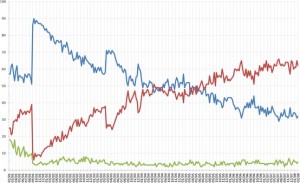Most people have pretty limited understanding of statistics and research analytics, and they’d probably say they are thankful for that fact, but the reality is that we are bombarded with stats and surveys and analytics every time we watch TV, listen to the radio, log onto the Internet, or go grocery shopping.
So how do companies gather the information they use in their advertising and marketing? How do we know what we’re hearing is legitimate?
When we do a survey and want to determine whether we’re getting an accurate measurement, we need to know if the sample is “statistically valid.” In other words, did we ask enough people to represent the entire population of people we’re studying.
Let’s try an example: Let’s say we want to find out what percentage of the population of Louisville, Kentucky, would say vanilla is their favorite flavor of ice cream.
The best, most accurate way to find out would be to ask every single person in Louisville. But at 1,000,000 people in the region, that’s impossible. So statisticians and researchers have created methods that allow us to ask a sample of the population to get that information we want.
So what is a small enough sample that we can predict how many Louisvillians like vanilla ice cream? Half a million? No. How about 100,000? No, smaller. Maybe 10,000? Nope.
Surprisingly enough, for a population of about one million people, we would only need to survey 384 people to get a reliable answer. There are specific factors we have to consider regarding who to pick, making sure all pockets of the population are included, and the quality of the research basis, but if we can satisfy all those factors, we only have to talk to 384 people total.
And if 80% of those 384 people said vanilla’s the way to go, we would have a margin of error of 5% and we could be confident that 75% to 85% of the entire one million people in Louisville said vanilla was their favorite flavor. (We discussed margin of error in a previous post.)
What’s fascinating is if we wanted to widen our population count to, say 100 million people, you might think we have to ask 38,400 people. Not so. If you wanted to find out how many people out of 100 million would vote for vanilla, you only need to survey 385 people. It is still a statistically valid sample with just 385 people, and still able to gauge the ice cream preferences of one-third of the United States.
After you hit the 10,000 mark in your population, the number needed to survey goes up very slowly.
The world of surveys and statistics is fascinating to say the least, and there’s a lot to understand, but making sure your numbers are on par and statistically valid, is one essential element that makes research the amazing tool for business it can be.





